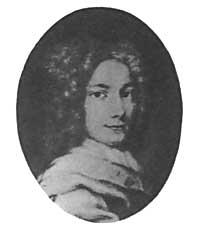Rene Descartes
French mathematician and philosopher born in The Hague (Tours area) on March 31, 1596. With one year her mother died and it seems that the bad health she suffered throughout her life was inherited from her mother.
When he reached the age of going to school, the cough was always desired, so he was often allowed to be in bed instead of going to school. He was a very quick student, but he kept the habit of working in bed all his life.

When he began to study with the Jesuits, Descartes was very religious. He did not cultivate a theory that would combat ecclesiastical doctrine, and proof of this is what happened to him in 1633. He was writing a book about the universe accepting the theory of Copernicus, but when the Church told him that he had condemned Galileo as heretical, he began to change his mind. According to the new hypothesis, the Earth was supported by a vertex, which was the one that revolved around the Sun, except for the Earth. Despite its inconsistency, this hypothesis was accepted by many savvy until Newton concealed the others for its gravitational theory.
After several years in the French army, Descartes settled in Holland until his almost death among the Protestants. He left the Netherlands in 1649 because he accepted an invitation from the Swedish court. Queen Cristina of Sweden wanted a famous philosopher around her to give fame to the court. However, her lifestyle and ideas were very special for the queen to give Descartes a kind of philosophy. Descartes' weak lungs did not have enough energy to withstand the Swedish red winter and died in Stockholm on 11 February 1650.
Descartes' body, except his head, was transferred to France and his head returned in 1809 when Bercelius sent it to the anatomist Cuvier.
At the time of Descartes, the language of flavours in Europe was Latin and therefore used in many of his works the Latin name “Renatus Cartesius”. That is why it is called “cartesian” to his philosophy and also to the united axes that are used in mathematics to represent equations. This representation system is induced by Descartes.
However, Descartes wrote during his life more in French than in Latin. XVII. In the 20th century, therefore, Latin as a universal language was declining in favor of Roman languages.
Descartes was mechanistic. He doubted everything, but the mere doubt meant that someone doubted and that someone had. He picked up this idea from the famous Latin saying: Cogito, ergo sum. The doctrine he formed from this foundation is said to be the father of modern philosophy.
He also applied mechanistic doctrine to the human body, based on the works of Vesalius and Harvey. Intelligence was out of the body and independent, but also communicated with the pineal gland of the brain. Descartes chose it because the animals did not have that gland. But he was wrong because years later the Danish Nikolaus Stenon found that gland in the animals.
Descartes also dealt with mathematics. When he was in the army he had a lot of time to think and then he started to work mathematics. The Cartesian coordinate system, they say, invented it by looking at a fly flying in bed. The position of the fly could be given by means of three intertwined planes, grouping the three planes at the point where the fly was. A point on a two-dimensional surface could be located by two straight joints that were cut at that same point.
Taking advantage of the Descartes coordinate system, any point in the plane could be defined with two numbers: (-3.1) for example. To define the points of space, three numbers were needed: (3,-4.2) for example.
Any algebra equation (such as the y = 3x2+2 equation) can be represented on the Cartesian axes of the plane. In fact, giving different values to the variable x we will obtain other values for and and moving these values to the Cartesian axes we will obtain the points of a curve. Each curve has an equation and each equation has a curve.
Descartes published this concept as an annex in a book dedicated to the universe in 1673. The truth is that the annex was much more important than the rest of the book.
Another contribution of Descartes was the combination of algebra and geometry and the enrichment of both. This combination later allowed Newton to develop his calculation. Because algebra was called “analysis,” Descartes’ union with two branches of mathematics is called analytical geometry.
Buletina
Bidali zure helbide elektronikoa eta jaso asteroko buletina zure sarrera-ontzian











